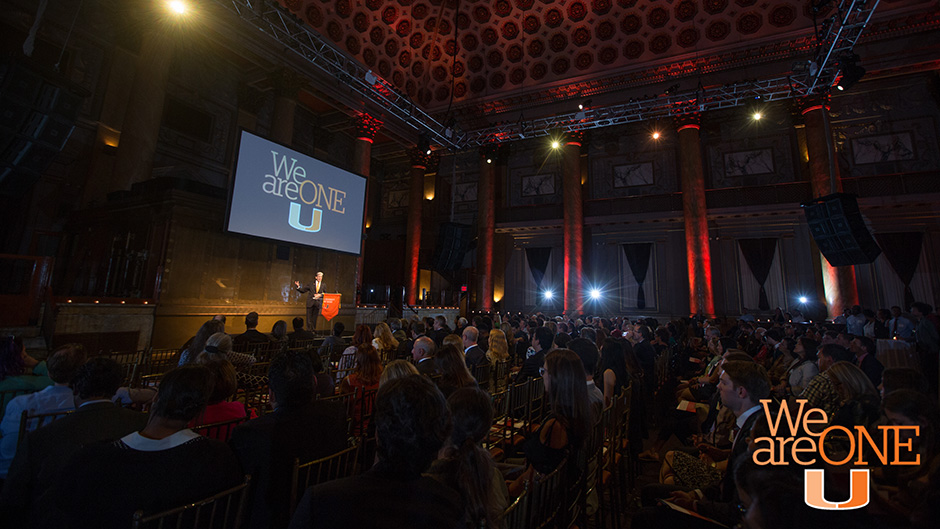One of the first alumni to arrive at the majestic, neo-classical CAPITALE on Manhattan’s Lower East Side, Brian Scandariato was eager to hear University of Miami President Julio Frenk’s impressions of his beloved alma mater.
He did not leave the reception hall disappointed.
“It was really exciting,” the 2003 graduate of the School of Architecture said after Frenk launched the University’s We Are One U tour Monday evening, which featured the first on-the-road ’Cane Talk. “He talked about how amazing the energy of the University is, which is exactly why I wanted to go there. I felt it the moment I stepped on campus.”
That special U spirit was as palpable as the symbolism in New York Monday evening, when amid the colossal Corinthian columns, Venetian glass, mosaic marble floors, and soaring vaulted ceilings of the old Bowery Savings Bank, Frenk discussed the “disruptive challenges” and “unprecedented opportunities” the University faces as it strives to become a hemispheric, excellent, relevant, and exemplary University by its centennial in 2025.
As he told about 400 alumni, parents, and supporters from the New York area, the building opened as an ordinary bank three years before the city of Miami’s 1896 incorporation, but its magnificence still stands as a monument to the human impulse for creativity and innovation.
Today, in its reincarnation, the beautiful old bank is also an example of resilience and renewal, not unlike what Frenk envisions the University of Miami will continue to be with the bold and imaginative initiatives that are the cornerstones of the Roadmap to Our New Century.
Drafted, debated, and refined by the University community over the past eight months, Frenk said the Roadmap is designed to guide the University through the rapidly changing future that many universities probably won’t survive. Not with vanishing federal funds for research, rising tuitions, a rapidly changing job market, and a business-as-usual attitude.
“The idea of the Roadmap is to make sure that we do not just wait for change to happen and see how we adapt,” Frenk said. “The universities that do that are not going to do very well. What we need to do is lead the change, embrace the change, and then be the leaders of that change. Define our future. This is what we are trying to do.”
And as Ben Kirtman, professor of atmospheric science at the Rosenstiel School of Marine and Atmospheric Science, demonstrated during one of the evening’s highlights, bold ideas don’t mean much without bold actions that benefit the greater good. Kirtman kicked off the evening by delivering the first on-the-road ’Cane Talk, the short presentations by leading thinkers in the UM community that illuminate the big questions we will face in the U’s next century.
As the head of UM’s Cooperative Institute for Marine and Atmospheric Science and the Center for Computational Science’s Climate and Environmental Hazards Program, Kirtman is at the forefront of one of the world’s most pressing problems, and one of particular significance to coastal cities like Miami and New York: rising seas brought on by climate change.
In his riveting talk, Kirtman described the computer models that, at the request of the National Oceanic and Atmospheric Administration, he and his team developed to predict extreme rainfall events caused by both natural variability and the changing climate, and to provide the seasonal forecasts that many of us rely on when planning our summer vacations during hurricane season.
“The University of Miami is making predictions today with the tools that we developed based on our science that the federal government uses on a day-to-day basis. This is a remarkable achievement,” Kirtman said. “These are official forecasts that NOAA uses when you are planning your Caribbean vacation.”
And these, Frenk said, are exactly the kind of real-world achievements and contributions that will give UM its staying power, well into its second and third centuries.
“Look at yourselves. We are the producers of human talent,” the president told the audience. “It’s this idea of a magnet for talent that I think is the key to what we want to do at the University…if you look at the U and turn it sideways it is like a magnet, so it’s there to attract all that energy.”
In the audience, along with Scandariato, multiple generations of ’Canes celebrated the U’s magnetic pull. They ranged in age from Brianna Hathaway, who was president of the Student Government when Frenk took office a year ago, to 89-year-old Alfred Carapella, the first UM football player to be named an All-American. The UM Hall of Famer earned his bachelor’s in education in 1951 and, after playing with the San Francisco 49ers, spent his career teaching.

